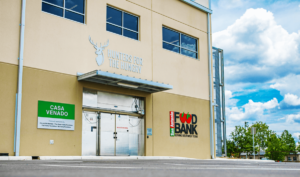For some, innovation means thinking outside the box. For South Carolina’s Lowcountry Food Bank, innovation has meant putting the box outside.
Lowcountry installed an outdoor refrigerated shipping container (known as a “Conex,” short for Container Express) at each of three partner agency locations. The 10×20-foot outdoor units, which were installed for $35,000 apiece, are transforming access to fresh, perishable produce in the South Carolina Lowcountry.
Like many food banks, one of Lowcountry’s biggest challenges in addressing nutrition security is the ability of partner agencies to store fresh produce. Lack of refrigerated storage becomes an operational chokepoint, limiting what agencies can accept and forcing them to distribute what they receive in one day or face the prospect of wastage. Given Lowcountry’s commitment to equitable access to nutritious food throughout the ten coastal counties it serves, the challenge is particularly acute in hard-to-reach rural communities, where need tends to be highest.
“The Conex gives an alternate level of flexibility,” said Nick Osborne, President and CEO of Lowcountry.
The outdoor refrigerated units, which were installed last year, have had an across-the-board impact. They’ve enabled Lowcountry to transport produce directly from source to agency, without an interim stop at a regional distribution center, saving gas and reducing food wastage. Deliveries are simpler too. Agencies can move pallets directly from trucks into the units without having to move through tight indoor spaces and with fewer volunteers. Completing the chain, the ability to store fresh produce longer gives agencies more flexibility in scheduling distributions and meeting individual client needs.
The proof is in the numbers. Comparing April through November 2021 (after the units were installed) with the same period in 2020, the three partner agencies with Conexes distributed 45% more fresh produce — an increase of 72,259 pounds equivalent to $83,098 in potential client savings (based on the USDA Thrifty Food Plan, which estimates the cost of produce at $1.15 per pound). Based on these potential client savings, Lowcountry calculates the time to recover the total cost of the units at ten months, or between six and 20 months, depending on the agency.
The Conexes took roughly two months to install, including pouring a concrete slab and electrical work. Osborne cautioned that, while locating a refrigerated Conex vendor is not terribly difficult, supply chain issues with refrigeration units could cause delays. Once installed, operating costs are minimal, because the units can be turned off when not in use.
Lowcountry encountered a few surprises, including the need for a ramp to wheel pallets up the raised concrete slab and upgrades to some electrical systems to accommodate the units. Osborne also notes that the Conex doors are heavy and require regular greasing and oiling.
Lowcountry plans to add three more Conexes this year. To Osborne, innovative solutions like the Conexes promise to play a critical role in expanding the “broader ecosystem” Lowcountry serves, increasing the capacity of its partner agencies to serve their clients and, he hopes, support one another. – Amanda Jaffe
Amanda Jaffe is a writer and former attorney with a deep interest in the organizations and mechanisms that address food insecurity. Her writing has appeared in The American Interest, PASSAGE Magazine, and the Finder, among other publications.
Like what you’re reading?
Support Food Bank News








